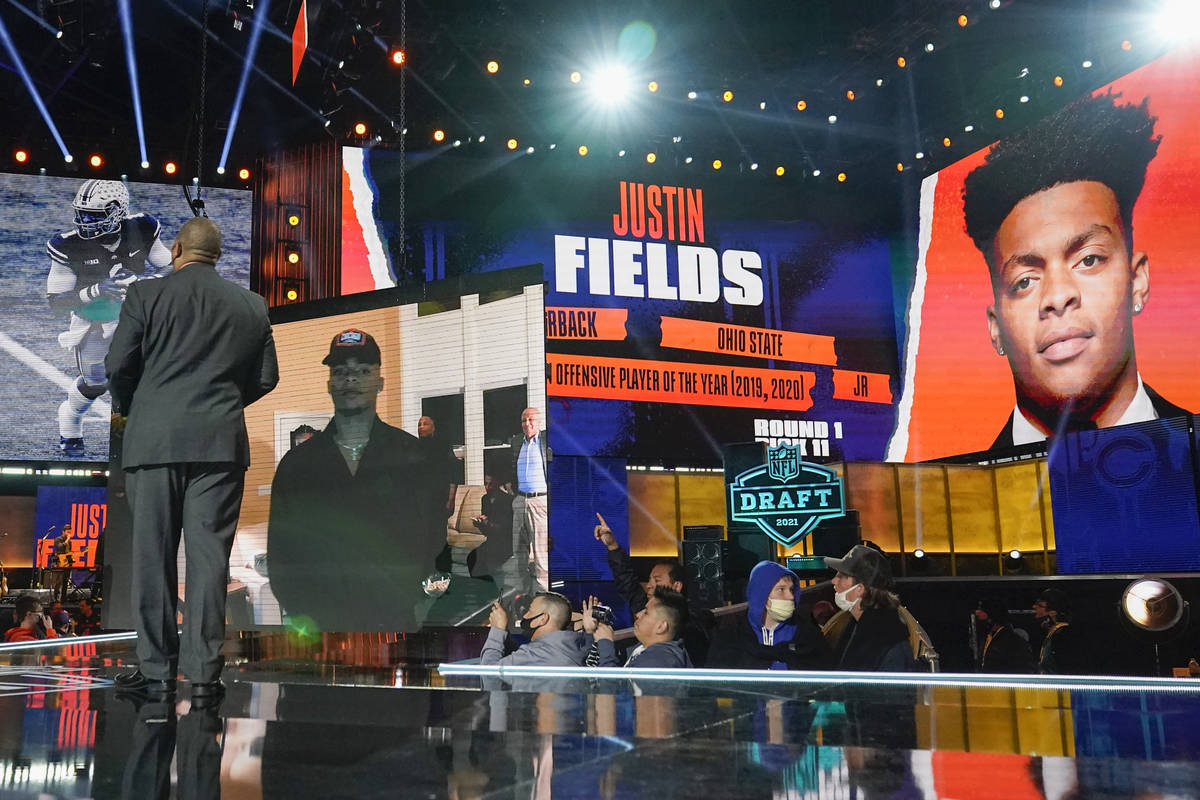RJ mock draft recap: Thank you Bears, Justin Fields

When the Chicago Bears traded up to take quarterback Justin Fields in the first round of the NFL draft on Thursday night, I gave a little bit of a fist pump.
Not that I have any rooting interest in the Bears or any connection at all. Fields isn’t exactly one of my favorite players either, seeing as how he played for Ohio State and I was raised as a die-hard Michigan fan.
No, my brief moment of excitement was even more trivial. My final mock draft, published on Thursday in the Review-Journal, called for the Bears to trade up in the first round to select Fields.
Sure, I guessed the Bears’ deal would be with a different team.
But, come on. I’m going to give myself full credit for that one. I need it. The rest of the mock draft was, well, laughable.
The first two picks were exact matches, but let’s face it, those were free spaces with quarterbacks Trevor Lawrence to Jacksonville and Zach Wilson to the Jets. Those picks were all but confirmed weeks and even months before the draft in Lawrence’s case.
Most analysts believed the draft started at No. 3 and had the 49ers taking quarterback Mac Jones, so I went with Jones but with a caveat. I said Fields would have been my choice with quarterback Trey Lance a close second. Essentially, anybody but Jones.
The 49ers did just that, and Jones fell all the way to No. 15 and New England, where I had slotted him in the first few incarnations of our mock draft at the beginning of the process.
My prediction of the Falcons trading the fourth pick to the Bears to take Fields did not come true, though the addendum was that Atlanta would pick Kyle Pitts should they keep the pick. That was true, along with the call of Ja’Marr Chase to Cincinnati at No. 5.
I had offensive tackle Penei Sewell going No. 7 to the Chargers in a trade. He did go in that spot, though it was the Lions who stayed in the spot and picked the Oregon tackle.
That’s where it got ugly. While the next group of players all matched up, the order wasn’t even close. Things didn’t get completely off the rails until the Jets traded up to get offensive lineman Alijah-Vera Tucker at No. 14 when I had him slotted at 18th.
Then the Cardinals and Raiders took my mock draft behind the woodshed and put it out of its misery. Linebacker Zaven Collins went to Arizona and the Raiders selected offensive tackle Alex Leatherwood, neither of whom was inside of my first round.
The same could be said about Pittsburgh taking Alabama running back Najee Harris at No. 24 and Jacksonville following it up with Clemson running back Travis Etienne one pick later, but I’m not even going to dock myself any points for those misses. That’s on them.
There were exactly zero running backs in my mock draft because taking running backs in the first round should be a cardinal sin in the NFL on par with punting from midfield on fourth-and-1.
The only other real victory was hitting on defensive end Kwity Paye to go to the Colts at No. 21, which wasn’t an overly common call. I’ll take it.
All in all, my second year of really diving deep into this exercise produced mixed results. Five players went in the predicted spot and 23 of 32 first-round picks did in fact get selected on the first night.
It was more accurate than last year, but there is still plenty of room to improve.
One of the biggest lessons is to stop assigning so many picks based on need. The ironic part of that is one of my common refrains is that teams should draft the best player available regardless of need. Yet when I do mock drafts, it’s always about what holes teams have to fill.
I also said last year one of my biggest mistakes was throwing in too many trades because when they don’t happen it can mess up the entire rest of the board.
Yet I did it again as soon as No. 4. It was a move warranting mockery.
Next time, I’ll be sure to include fewer trades.
Oh, and to remember that the Raiders will pick a player from Clemson or Alabama who experts predict will go in the second or third round.
See, this mock draft stuff isn’t that hard after all.
Contact Adam Hill at ahill@reviewjournal.com. Follow @AdamHillLVRJ on Twitter.